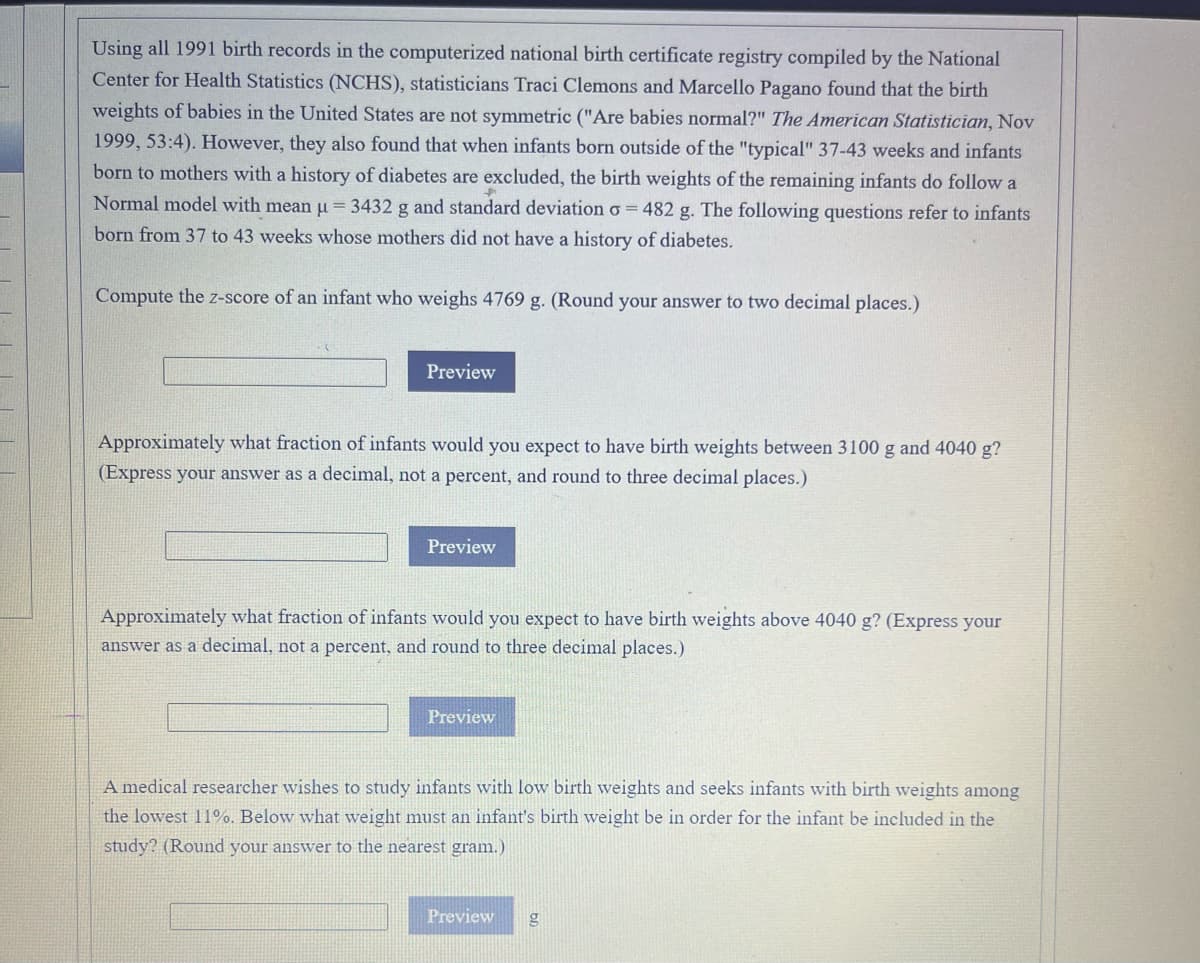Using all 1991 birth records in the computerized national birth certificate registry compiled by the National Center for Health Statistics (NCHS), statisticians Traci Clemons and Marcello Pagano found that the birth weights of babies in the United States are not symmetric ("Are babies normal?" The American Statistician, Nov 1999, 53:4). However, they also found that when infants born outside of the "typical" 37-43 weeks and infants born to mothers with a history of diabetes are excluded, the birth weights of the remaining infants do follow a Normal model with mean u= 3432 g and standard deviation o = 482 g. The following questions refer to infants born from 37 to 43 weeks whose mothers did not have a history of diabetes. Compute the z-score of an infant who weighs 4769 g. (Round your answer to two decimal places.) Preview Approximately what fraction of infants would you expect to have birth weights between 3100 g and 4040 g? (Express your answer as a decimal, not a percent, and round to three decimal places.) Preview Approximately what fraction of infants would you expect to have birth weights above 4040 g? (Express your answer as a decimal, not a percent, and round to three decimal places.) Preview A medical researcher wishes to study infants with low birth weights and seeks infants with birth weights among the lowest 11%. Below what weight must an infant's birth weight be in order for the infant be included in the study? (Round your answer to the nearest gram.) Preview
Using all 1991 birth records in the computerized national birth certificate registry compiled by the National Center for Health Statistics (NCHS), statisticians Traci Clemons and Marcello Pagano found that the birth weights of babies in the United States are not symmetric ("Are babies normal?" The American Statistician, Nov 1999, 53:4). However, they also found that when infants born outside of the "typical" 37-43 weeks and infants born to mothers with a history of diabetes are excluded, the birth weights of the remaining infants do follow a Normal model with mean u= 3432 g and standard deviation o = 482 g. The following questions refer to infants born from 37 to 43 weeks whose mothers did not have a history of diabetes. Compute the z-score of an infant who weighs 4769 g. (Round your answer to two decimal places.) Preview Approximately what fraction of infants would you expect to have birth weights between 3100 g and 4040 g? (Express your answer as a decimal, not a percent, and round to three decimal places.) Preview Approximately what fraction of infants would you expect to have birth weights above 4040 g? (Express your answer as a decimal, not a percent, and round to three decimal places.) Preview A medical researcher wishes to study infants with low birth weights and seeks infants with birth weights among the lowest 11%. Below what weight must an infant's birth weight be in order for the infant be included in the study? (Round your answer to the nearest gram.) Preview
Holt Mcdougal Larson Pre-algebra: Student Edition 2012
1st Edition
ISBN:9780547587776
Author:HOLT MCDOUGAL
Publisher:HOLT MCDOUGAL
Chapter11: Data Analysis And Probability
Section: Chapter Questions
Problem 8CR
Related questions
Question
100%

Transcribed Image Text:Using all 1991 birth records in the computerized national birth certificate registry compiled by the National
Center for Health Statistics (NCHS), statisticians Traci Clemons and Marcello Pagano found that the birth
weights of babies in the United States are not symmetric ("Are babies normal?" The American Statistician, Nov
1999, 53:4). However, they also found that when infants born outside of the "typical" 37-43 weeks and infants
born to mothers with a history of diabetes are excluded, the birth weights of the remaining infants do follow a
Normal model with mean u = 3432 g and standard deviation o = 482 g. The following questions refer to infants
born from 37 to 43 weeks whose mothers did not have a history of diabetes.
Compute the z-score of an infant who weighs 4769 g. (Round your answer to two decimal places.)
Preview
Approximately what fraction of infants would you expect to have birth weights between 3100 g and 4040 g?
(Express your answer as a decimal, not a percent, and round to three decimal places.)
Preview
Approximately what fraction of infants would you expect to have birth weights above 4040 g? (Express your
answer as a decimal, not a percent, and round to three decimal places.)
Preview
A medical researcher wishes to study infants with low birth weights and seeks infants with birth weights among
the lowest 11%. Below what weight must an infant's birth weight be in order for the infant be included in the
study? (Round your answer to the nearest gram.)
Preview
Expert Solution
This question has been solved!
Explore an expertly crafted, step-by-step solution for a thorough understanding of key concepts.
This is a popular solution!
Trending now
This is a popular solution!
Step by step
Solved in 4 steps

Recommended textbooks for you

Holt Mcdougal Larson Pre-algebra: Student Edition…
Algebra
ISBN:
9780547587776
Author:
HOLT MCDOUGAL
Publisher:
HOLT MCDOUGAL

Algebra & Trigonometry with Analytic Geometry
Algebra
ISBN:
9781133382119
Author:
Swokowski
Publisher:
Cengage

Holt Mcdougal Larson Pre-algebra: Student Edition…
Algebra
ISBN:
9780547587776
Author:
HOLT MCDOUGAL
Publisher:
HOLT MCDOUGAL

Algebra & Trigonometry with Analytic Geometry
Algebra
ISBN:
9781133382119
Author:
Swokowski
Publisher:
Cengage